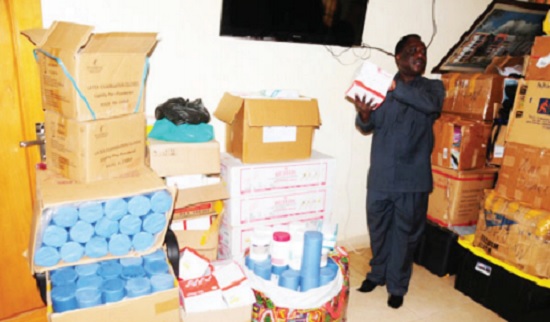
Uncovering the underworld of how Uganda’s marked medicines are stolen and sold
Kampala, Uganda | FLAVIA NASSAKA | We have been waiting for close to two hours when a man emerges from a nearby thicket with water from the afternoon drizzle dripping like white beads off his very dark face and compact body. He signals his colleague to join him at the other side of the road from where we are standing and they speak for about 20 minutes.
It’s July 25, and I am in Opia, a deserted village in Vurra Sub County at the Uganda – Democratic Republic of Congo border in Arua district. My mission is to find out how medicines and sundries from Uganda government stores end up in the DR Congo.
Finally, an agreement appears to have been reached between the two men. The man from DR Congo has agreed to talk to me but with some conditions; including no use of names or cameras. He asks to confirm that I am a journalist and I give him my identity card.
Finally, he suggests that we find a more comfortable place, out of the drizzle, for the interview. But as we ride on his number plate less yellow bike on the Ugandan side of the border, the man from DR Congo is already telling me stories about how Ugandan drugs have become a savior in the neighboring country – and a money maker for him.
The man confirms that he is Congolese and works for a health facility called Yofenyiri Health Center, just across the border in DR Congo. He says drug shortages have worsened since the government there contracted the supply to hospitals and health facilities in the Ituri province to an NGO of the Catholic Church – Malteser International, from the island nation of Malta located in the Mediterranean Sea between North Africa and Italy.
Ituri province is huge; about the size of northern Uganda and riven with warlords and bandits – making it difficult for Malteser to deliver medicines.
“You make an order today they will bring the drugs after two months, three months,” says my man, who adds that when patients come to his health facility and find he doesn’t have drugs, they will run away to other clinics.
“That’s why I decided to get an agent from Arua hospital,” he explains in the difficult Congolese English.
When we arrive at our destination, he opens a box which is covered in several jackets in a sack. He has just purchased a box full of, largely, the antimalarial drug Coartem, antibiotics, straps of Paracetamol, and gloves. All are labeled ‘Government of Uganda, Not for Sale’.
“These cost me 400,000 shillings,” he says.
The man from DR Congo says 80% of cases at his Yofenyiri facility suffer from malaria and the medicines he has bought so far are not enough to meet the demand. Yet, he says, his colleague from Ikara health facility also in Ituri province of DR Congo had called him two days ago requesting for anti-malarial medicines.
“I will not be able to supply them,” he says. His facility, he says, is located just eight kilometers away from the border and he has used this proximity to his advantage. He is now the link person between Ugandan medicine dealers and the health facilities deeper in the DR Congo that buy them.
Every month, he says, he buys fresh supplies of medicines of up to Shs800, 000 from Uganda. He wants more medicines.
“You know Uganda drugs are cheap,” he says, “They also tell us the expiry dates when selling to us.”
He says the Congolese trust Ugandan medicines and medical facilities.
“My friends also ask me whether the person bringing the drugs is a doctor,” he says.
Threats to Uganda
As he constantly combs West Nile health facilities for these drugs, he appears oblivious that their rightful beneficiaries in Uganda are going without their doses. He might be a very small player in a very big racket, but does he even know that his business presents a serious threat to the already fragile Ugandan health system?
This financial year, the government of Uganda plans to spend Shs277 billion on drugs. It is not clear how much of that the country will lose to theft as there is currently no published data to show the exact extent of the drug theft problem. However, anecdotal evidence indicates a lot of drugs are getting stolen.
At the Ministry of Health headquarters in Kampala, for instance, Dr Jimmy Opigo; the Manager of the Malaria Control programme says last year, 21 million doses of antimalarials were procured and only 14.5 million doses were reported as used.
“We don’t know where the six million treatments went,” he says, “There was a big stock out.”
The Ministry of Health has since 2017 been subsidising anti-malaria drugs sold in some private pharmacies. The medicines which bear a green leaf are recommended to be sold at US$1 or less per dose. Up to US$4 million provided by the Global Fund is to be spent on the subsidy each year until 2019. Another US$3.2million is to be spent on monitoring supply and providing information on malaria patient care.
If Dr Opigo’s numbers are correct, the missing six million treatments represent an addition US$6 million (Approx. Shs22 billion). That is money going to medicine smugglers like my man from the DR Congo.
After our meeting, I headed to Arua Regional Referral Hospital, where he claims to be getting some of his drugs. But its Principal Administrator, Michael Odur, says the hospital is not connected to the DR Congo medicine racket.
“I’ve been here since November (last year). None of our hospital staff has been arrested,” he says, “We only hear that Uganda drugs are on sale in Congo but we have not had a case here.”
Odur says Arua hospital, like many others around the country usually gets stock outs of the malaria drug, Artesunate and others like Fragyl and antibiotics Amoxyl and Ceftriaxone injection in addition to gloves and stitchers.
But, he says, the constant stock outs are not because drugs are stolen.
“We get supplies in six cycles every year,” he says, “about 180 million every cycle but this is just a drop in the ocean. We always suffer stock outs.”
“We get a high number of unbudgeted for patients from neighboring Congo and of late refugees from South Sudan,” he adds.
Every day, he says, the hospital handles around 400 out patients and 350 in patients and 33% of these are Congolese seeking mostly care for HIV, Malaria, pneumonia or maternal and child health services. Because of the patient pressure, Arua hospital was this year given an extra Shs240million on top of its annual Shs1billion budget.
 The Independent Uganda: You get the Truth we Pay the Price
The Independent Uganda: You get the Truth we Pay the Price



